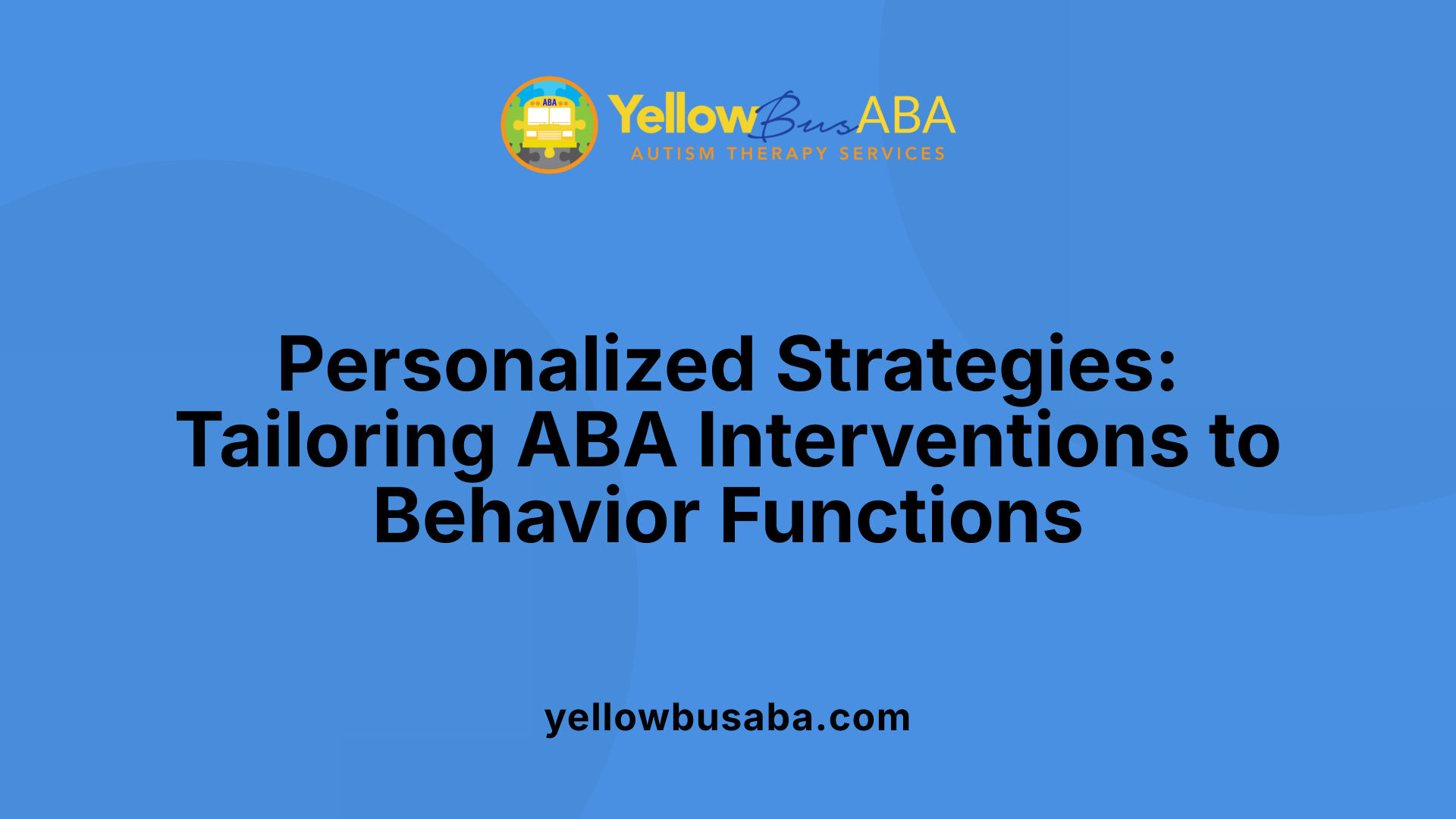The Real Meaning of “Behavior Functions” in ABA
November 19, 2025
Unlocking Behavior Functions: The Key to Successful ABA Therapy

Understanding Behavior Functions in ABA Therapy
Applied Behavior Analysis (ABA) therapy is a leading evidence-based intervention for individuals with autism spectrum disorder (ASD). Central to ABA's efficacy is the concept of behavior functions — the underlying reasons why specific behaviors occur. Grasping behavior functions allows therapists to develop targeted strategies that promote meaningful skill development and reduce challenging behaviors. This article explores the real meaning of behavior functions in ABA, how these functions guide individualized therapy, and why understanding them benefits both individuals receiving and professionals providing ABA services.
What Are Behavior Functions and Why Do They Matter in ABA?

What is the real meaning of 'behavior functions' in ABA?
Behavior functions refer to the reasons or purposes behind specific behaviors exhibited by individuals, especially children with autism. Essentially, these functions explain why a particular behavior occurs—what the individual gains or tries to avoid by engaging in that behavior. Understanding these motivations is crucial in Applied Behavior Analysis (ABA) because it allows therapists to pinpoint what reinforces or maintains behavior, providing a pathway to develop targeted, effective interventions.
Why are behavior functions important in ABA therapy?
Recognizing the function of a behavior forms the foundation for successful ABA treatment. Once therapists identify why a behavior happens, they can construct intervention strategies that either teach appropriate alternative behaviors or modify the environment to reduce unwanted behaviors. This tailored approach increases the chances of lasting positive outcomes and helps children develop more adaptive skills across settings.
What are the main categories of behavior functions?
Behavior in ABA is generally categorized into four primary functions, often remembered by the acronym SEAT:
- Sensory: Behaviors that provide self-stimulation or help avoid discomfort, such as hand flapping or rocking.
- Escape: Actions aimed at avoiding or delaying unpleasant tasks or situations.
- Attention: Behaviors designed to gain social interaction or reactions from others, such as crying or yelling.
- Tangible: Behaviors that seek access to preferred items or activities, like toys or snacks.
Some models also include additional functions like communication and control, recognizing the complexity behind actions. Understanding these categories allows ABA therapists to perform functional behavior assessments that inform precise intervention methods.
By focusing on behavior functions, ABA professionals can deliver customized care that not only reduces challenging behaviors but also promotes positive, meaningful behavior change.
The Four Primary Functions of Behavior in ABA: SEAT Framework

What are the Common Functions of Behavior in ABA?
The four primary functions of behavior in Applied Behavior Analysis (ABA) are Sensory, Escape, Attention, and Tangible. These are often abbreviated as SEAT, providing a straightforward framework for understanding why behaviors occur.
Detailed Description of the Sensory, Escape, Attention, and Tangible Functions
Sensory (S): Behaviors driven by sensory needs involve seeking or avoiding specific sensory inputs. Examples include hand flapping, rocking, or repetitive movements. These behaviors often serve to regulate internal sensory experiences rather than communicate with others.
Escape (E): These behaviors are attempts to avoid or delay non-preferred tasks or situations. A child may walk away from a task or verbally refuse to comply. This function helps the child reduce exposure to uncomfortable or challenging demands.
Attention (A): This function involves behaviors aimed at gaining social interaction or feedback from others, such as crying, screaming, or hitting. The child seeks connection or response, whether positive (praise) or negative (scolding).
Tangible (T): Children engage in these behaviors to access preferred items or activities, such as toys, food, or electronics. Examples include begging or tantrums when a desired object is not available.
Examples Illustrating Each Function
| Function | Example Behavior | Explanation |
|---|---|---|
| Sensory | Hand flapping | Self-stimulation for sensory input |
| Escape | Walking away | Avoiding completing a non-preferred task |
| Attention | Screaming | Seeking adult attention or interaction |
| Tangible | Tantrum over toy | Trying to obtain a desired item |
How SEAT Helps Categorize Behaviors in ABA
The SEAT framework is used by behavior analysts to quickly identify the underlying reason for specific behaviors. By categorizing behaviors into these four functions, interventions can be tailored effectively. For example, teaching alternative communication might address attention-seeking behaviors, while providing sensory tools can help with sensory-driven actions. Understanding these functions leads to more precise, individualized strategies that promote positive behavioral outcomes.
Assessing Behavior Functions: Tools and Techniques in ABA

How are behavior functions assessed in ABA therapy?
Identifying the function of a behavior is essential in Applied Behavior Analysis (ABA) therapy to develop effective, individualized interventions. This identification process is carried out through a Functional Behavior Assessment (FBA).
What does a Functional Behavior Assessment include?
An FBA is a comprehensive approach that typically involves several methods:
- Direct Observation: Clinicians observe the child in natural settings to see when and where the behavior occurs.
- Interviews: Talking with caregivers, teachers, and others familiar with the child helps gather insights about the behavior's context.
- Functional Analysis: This experimental method manipulates environmental variables to confirm which conditions trigger or reinforce the behavior.
How is the ABC model used in behavior assessment?
A cornerstone of behavior assessment in ABA is the ABC model, which stands for Antecedent-Behavior-Consequence:
- Antecedent: What happens immediately before the behavior? This could be a command, a specific setting, or an interaction.
- Behavior: What the child does, such as crying, hitting, or flapping hands.
- Consequence: What happens immediately after the behavior, including attention, escape from a task, or access to a preferred item.
By analyzing these three components, therapists can determine the reason behind a behavior. For example, if a child screams to get attention and consistently receives it, the function is identified as attention-seeking.
This comprehensive assessment allows behavior analysts to tailor interventions that address the specific reasons any behavior occurs, thereby improving therapy outcomes.
| Assessment Component | Purpose | Description |
|---|---|---|
| Observation | Identify when and where behavior occurs | Watching the child in natural environments |
| Interview | Collect contextual information | Gathering reports from caregivers and teachers |
| Functional Analysis | Experimentally test behavior triggers | Manipulating environment to confirm behavior function |
| ABC Model | Analyze behavior events | Dissecting antecedents, behaviors, and consequences |
Tailoring ABA Interventions Based on Behavior Functions

How does understanding behavior functions contribute to intervention strategies in ABA?
Understanding the function behind a behavior is crucial in ABA therapy. Once the specific reason for a behavior—such as escape, attention-seeking, access to tangibles, or sensory stimulation—is identified, therapists can create interventions tailored to meet that underlying need in a positive way.
How identifying functions shapes intervention planning
Behavior analysts conduct Functional Behavior Assessments (FBAs) using tools like observation and interviews to determine why a behavior occurs. This assessment allows the design of a precise intervention that focuses on the motivation behind the behavior, rather than just the behavior itself. For example, if a child’s behavior is driven by the desire to escape a task, interventions may include teaching self-advocacy skills or using visual schedules to provide predictability and reduce anxiety.
Examples of function-based strategies
- Escape/Avoidance: Implement visual schedules and teach self-advocacy to help the child manage non-preferred tasks.
- Attention-Seeking: Teach alternative communication skills such as asking for attention appropriately, rather than using disruptive behaviors.
- Tangible Reinforcement: Use preferred items or activities as rewards while teaching the child to request access appropriately.
- Sensory Stimulation: Provide appropriate sensory tools or outlets to meet sensory needs safely.
Teaching alternative, appropriate behaviors
Targeted interventions focus on teaching replacement behaviors that serve the same function as the challenging ones. For instance, a child who engages in tantrums to gain attention might be taught to use simple phrases or gestures to request attention instead. This approach minimizes problem behaviors by fulfilling the child's needs in socially acceptable ways. Ultimately, these function-based strategies promote positive, lasting behavioral changes.
How ABA Therapy Works: Professionals, Personalization, and Practices
Who typically provides ABA therapy services and what qualifications do they have?
ABA therapy services are delivered by trained specialists with distinct roles and qualifications. These include Board Certified Behavior Analysts (BCBAs), Board Certified Assistant Behavior Analysts (BCaBAs), and Registered Behavior Technicians (RBTs).
BCBAs are highly qualified professionals holding advanced degrees in behavior analysis or related fields. They are responsible for designing comprehensive treatment plans tailored to the individual's needs. BCaBAs assist BCBAs by supporting program implementation. RBTs carry out the daily therapy sessions under the supervision of BCBAs or BCaBAs. All practitioners maintain certification and adhere to rigorous ethical standards to ensure that care is both personalized and grounded in scientific evidence.
How is an individual's ABA therapy program customized to meet specific needs?
Individualized ABA therapy begins with thorough assessments to identify each person's strengths, challenges, and specific behaviors. This process includes observations, interviews, and data collection, helping to pinpoint the function of behaviors and skill gaps.
Based on this information, behavior analysts craft customized treatment plans with clear, measurable goals. These plans incorporate techniques such as positive reinforcement and the Antecedent-Behavior-Consequence (ABC) model to teach new skills and reduce problematic behaviors. The therapy's intensity and strategies are continuously adjusted, reflecting ongoing progress measurements.
Family and caregiver involvement is integral, with training provided to support skill development in natural environments. This collaboration ensures that gains made during therapy generalize to everyday life, fostering lasting positive outcomes.
Data-driven progress monitoring and caregiver involvement
Consistent data collection allows therapists to objectively evaluate the effectiveness of interventions. By tracking specific behaviors and skill acquisition, adjustments can be made promptly to improve outcomes.
Caregivers are trained to reinforce skills outside therapy sessions, creating a supportive environment that enhances learning and behavior change. This partnership between professionals and families maximizes the benefits of ABA therapy and promotes greater independence for the individual.
The Essential Role of Families and Caregivers in ABA Success

What role do families and caregivers play in ABA therapy success?
Families and caregivers are fundamental to the effectiveness of ABA therapy. They receive training to understand behavioral principles and learn how to implement intervention strategies consistently. This ongoing involvement ensures that the skills a child acquires in therapy generalize effectively across different settings, such as home, school, and the community.
Family and caregiver training and involvement
Through education and coaching, families become equipped to reinforce positive behaviors and teach alternative skills in everyday contexts. This collaborative approach helps maintain progress by providing a consistent structure beyond therapy sessions.
Generalization of learned skills across environments
One of the challenges in behavior management is transferring new skills to real-life situations. Family engagement facilitates this by embedding intervention techniques into the child's daily routines, making the learned behaviors functional and durable.
Collaboration between therapists and families
Regular communication between therapists and families allows for tailored and flexible treatment plans responsive to the child’s evolving needs. This partnership promotes shared goals, leading to better outcomes and fostering the child’s independence and growth.
Challenges and Ethical Considerations in ABA Therapy
Are there challenges or criticisms of ABA therapy for autism?
ABA therapy, while widely recognized for its effectiveness, has faced historical criticisms. Early ABA practices were sometimes criticized for being rigid and repetitive, occasionally employing aversive techniques that raised concerns regarding emotional well-being and pressures to conform. These concerns underscored the need for more compassionate and individualized approaches.
In response, ABA has evolved significantly. Modern methods emphasize naturalistic and personalized treatments that respect neurodiversity. Therapists now balance the development of skills with emotional support, fostering environments that encourage positive growth without compromising the individual's dignity or well-being.
How do specialized companies ensure quality and ethical standards in ABA services?
Specialized ABA providers implement comprehensive measures to maintain quality and ethics. They adhere strictly to professional guidelines and maintain continuous training programs to keep staff updated on best practices.
Further, these providers use data-driven oversight and ethical review committees to monitor treatment quality and client welfare. Transparency with families, cultural sensitivity, and compliance with privacy laws are prioritized to build trust and ensure respectful care.
Regular evaluations of treatment effectiveness are conducted, allowing adjustments to therapy plans that best meet client needs while safeguarding ethical standards. This multi-faceted approach assures high-quality ABA services centered on respect, safety, and individualized support.
Bringing Behavior Functions to Life in ABA Therapy
Understanding behavior functions is indispensable in Applied Behavior Analysis therapy, providing the essential framework for why behaviors occur and how best to address them. By categorizing these functions into sensory, escape, attention, and tangible needs, ABA therapists can craft personalized and effective interventions that teach meaningful alternative behaviors. The collaboration of trained professionals with families creates an environment where skills can generalize and flourish. Despite its challenges, ABA continues to adapt and prioritize ethical, respectful approaches to ensure every individual's progress and dignity. Ultimately, unlocking the real meaning of behavior functions fosters more compassionate, tailored, and successful therapy outcomes for individuals with autism.
References
- Understanding the Functions of Behavior in ABA
- ABA Therapy and Behavior Functions
- The Four Functions of Behavior: Understanding Your ...
- Functions Of Behavior In ABA: Why Behaviors Happen
- Applied Behavior Analysis (ABA)
- What are the 4 Behavior Functions of ABA Therapy?
- The effectiveness of applied behavior analysis program ...
- Applied Behavior Analysis (ABA)
- Scientific Support for Applied Behavior Analysis from the ...






